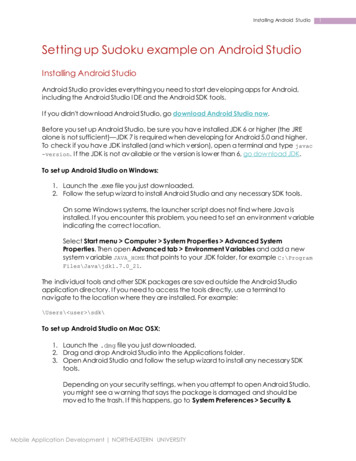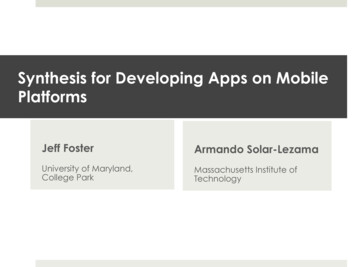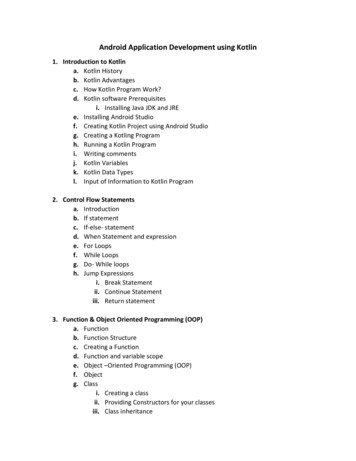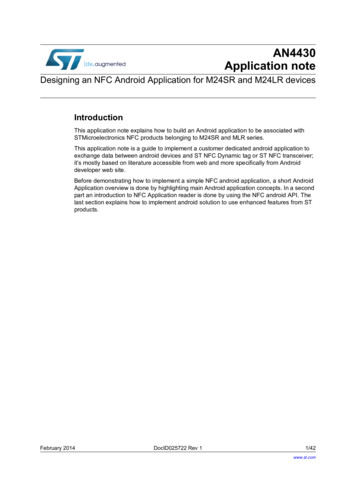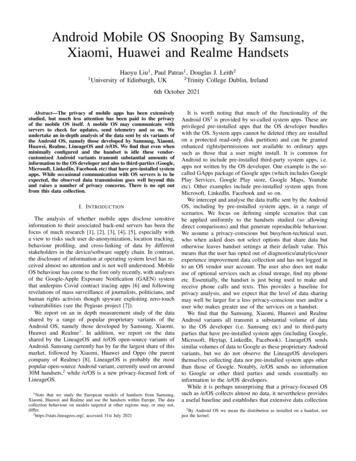
Transcription
Android Mobile OS Snooping By Samsung,Xiaomi, Huawei and Realme Handsets1 UniversityHaoyu Liu1 , Paul Patras1 , Douglas J. Leith22 Trinity College Dublin, Irelandof Edinburgh, UK6th October 2021Abstract—The privacy of mobile apps has been extensivelystudied, but much less attention has been paid to the privacyof the mobile OS itself. A mobile OS may communicate withservers to check for updates, send telemetry and so on. Weundertake an in-depth analysis of the data sent by six variants ofthe Android OS, namely those developed by Samsung, Xiaomi,Huawei, Realme, LineageOS and /e/OS. We find that even whenminimally configured and the handset is idle these vendorcustomized Android variants transmit substantial amounts ofinformation to the OS developer and also to third-parties (Google,Microsoft, LinkedIn, Facebook etc) that have pre-installed systemapps. While occasional communication with OS servers is to beexpected, the observed data transmission goes well beyond thisand raises a number of privacy concerns. There is no opt outfrom this data collection.I. I NTRODUCTIONThe analysis of whether mobile apps disclose sensitiveinformation to their associated back-end servers has been thefocus of much research [1], [2], [3], [4], [5], especially witha view to risks such user de-anonymization, location tracking,behaviour profiling, and cross-linking of data by differentstakeholders in the device/software supply chain. In contrast,the disclosure of information at operating system level has received almost no attention and is not well understood. MobileOS behaviour has come to the fore only recently, with analysesof the Google-Apple Exposure Notification (GAEN) systemthat underpins Covid contract tracing apps [6] and followingrevelations of mass surveillance of journalists, politicians, andhuman rights activists though spyware exploiting zero-touchvulnerabilities (see the Pegasus project [7]).We report on an in depth measurement study of the datashared by a range of popular proprietary variants of theAndroid OS, namely those developed by Samsung, Xiaomi,Huawei and Realme1 . In addition, we report on the datashared by the LineageOS and /e/OS open-source variants ofAndroid. Samsung currently has by far the largest share of thismarket, followed by Xiaomi, Huawei and Oppo (the parentcompany of Realme) [8]. LineageOS is probably the mostpopular open-source Android variant, currently used on around30M handsets,2 while /e/OS is a new privacy-focused fork ofLineageOS.1 Note that we study the European models of handsets from Samsung,Xiaomi, Huawei and Realme and use the handsets within Europe. The datacollection behaviour on models targeted at other regions may, or may not,differ.2 https://stats.lineageos.org/, accessed 31st July 2021It is worth noting that much of the functionality of theAndroid OS3 is provided by so-called system apps. These areprivileged pre-installed apps that the OS developer bundleswith the OS. System apps cannot be deleted (they are installedon a protected read-only disk partition) and can be grantedenhanced rights/permissions not available to ordinary appssuch as those that a user might install. It is common forAndroid to include pre-installed third-party system apps, i.e.apps not written by the OS developer. One example is the socalled GApps package of Google apps (which includes GooglePlay Services, Google Play store, Google Maps, Youtubeetc). Other examples include pre-installed system apps fromMicrosoft, LinkedIn, Facebook and so on.We intercept and analyse the data traffic sent by the AndroidOS, including by pre-installed system apps, in a range ofscenarios. We focus on defining simple scenarios that canbe applied uniformly to the handsets studied (so allowingdirect comparisons) and that generate reproducible behaviour.We assume a privacy-conscious but busy/non-technical user,who when asked does not select options that share data butotherwise leaves handset settings at their default value. Thismeans that the user has opted out of diagnostics/analytics/userexperience improvement data collection and has not logged into an OS vendor user account. The user also does not makeuse of optional services such as cloud storage, find my phoneetc. Essentially, the handset is just being used to make andreceive phone calls and texts. This provides a baseline forprivacy analysis, and we expect that the level of data sharingmay well be larger for a less privacy-conscious user and/or auser who makes greater use of the services on a handset.We find that the Samsung, Xiaomi, Huawei and RealmeAndroid variants all transmit a substantial volume of datato the OS developer (i.e. Samsung etc) and to third-partyparties that have pre-installed system apps (including Google,Microsoft, Heytap, LinkedIn, Facebook). LineageOS sendssimilar volumes of data to Google as these proprietary Androidvariants, but we do not observe the LineageOS developersthemselves collecting data nor pre-installed system apps otherthan those of Google. Notably, /e/OS sends no informationto Google or other third parties and sends essentially noinformation to the /e/OS developers.While it is perhaps unsurprising that a privacy-focused OSsuch as /e/OS collects almost no data, it nevertheless providesa useful baseline and establishes that extensive data collection3 By Android OS we mean the distribution as installed on a handset, notjust the kernel.
TABLE IS UMMARY OF DATA COLLECTION BY EACH A NDROID OS VARIANT.Long-livedDeviceIdentifiersSamsungIMEIs, hardwareserial numbersXiaomiIMEIs, SecureDeviceID,MD5 hash ofWifi MACaddressVAID, GoogleAd IDRealmeIMEI,deviceID, guidHuaweihardware serialnumber, deviceRSA certLineageOS-/e/OS-GoogleIMEI,hardware serialnumber, WifiMAC addressVAID, OAID,device id,registrationId,Google Ad ID,Firebase IDsGoogle,Heytap---AndroidID,Google Ad IDGoogle, DailyMotion, Avast,Qihoo bleIdentifiersRelinkable toDeviceSamsungConsumer ID,Firebase IDsThird-PartySystemApp DataCollectorsMain TelemetryCollectors (ByData Volume)Loggers of AppUsage OverTimeLoggers ofApps InstalledOn HandsetGoogle, MobileOperator,Microsoft,LinkedIn, ,HeytapGoogle,HuaweiGoogle-Google,Heytapby a mobile OS is neither necessary nor essential, but rathera choice made by the OS developer. Although occasional datatransmission to the OS developer to check for updates, etc. isto be expected, as we will see the observed data transmissionby the Samsung, Xiaomi, Huawei, Realme and LineageOSAndroid variants goes well beyond this.Table I summarises the data collected by each of theAndroid OS variants studied.Re-linkability of advertising identifiers. Samsung, Xiaomi,Realme and Google all collect long-lived device identifiers,e.g. the hardware serial number, as well as user-resettableidentifiers, such as advertising IDs. By analysing the identifierssent together in connections, we find that a long-lived deviceidentifier is sent alongside the resettable identifier on thesehandsets. This means that when a user resets an identifierthe new identifier value can be trivially re-linked back to thesame device. This largely undermines the use of user-resettableadvertising identifiers. See the second row of Table I for a listof resettable identifiers that can be re-linked to the handset inthis way.Data ecosystem. We also find that typically multiple partiescollect data from each handset and that considerable potentialexists for cross-linking of data collected by these differentparties. On every handset, apart from the /e/OS handset,Google collects a large volume of data. On the Samsunghandset the Google Advertising ID is sent to Samsung servers,a number of Samsung system apps use Google Analytics tocollect data and the Microsoft OneDrive system app usesGoogle’s push service. On the Huawei handset the MicrosoftSwiftkey keyboard sends the Google Advertising ID to Microsoft servers. On the Xiaomi handset the Google AdvertisingID is sent to Xiaomi servers, while on the Realme handset theGoogle Advertising ID is sent to Heytap (who partner withRealme/Oppo to provide handset services, so linkage of datacollected by Heytap and Realme is also possible).Recording of user interactions with handset. System appson several handsets upload details of user interactions withthe apps on the handset (what apps are used and when,what app screens are viewed, when and for how long). Theeffect is analogous to the use of cookies to track usersacross web sites. On the Xiaomi handset the system appcom.miui.analytics uploads a time history of the app windowsviewed by the handset user to Xiaomi servers. This revealsdetailed information on user handset usage over time, e.g.timing and duration of phone calls. Similarly, on the Huaweihandset the Microsoft Swiftkey keyboard (the default systemkeyboard) logs when the keyboard is used within an app,uploading to Microsoft servers a history of app usage overtime. Again, this is revealing of user handset usage over timee.g. writing of texts, use of the search bar, searching forcontacts. Several Samsung system apps use Google Analyticsto log user interactions (windows viewed etc). On the Xiaomiand Huawei handsets the Google messaging app (the systemapp used to send and receive SMS texts) logs user interactions,including when an SMS text is sent. In addition, with thenotable exception of the /e/OS handset, Google Play Servicesand the Google Play store upload large volumes of data fromall of the handsets (at least 10 that uploaded by the mobileOS developer). This has also been observed in other recentstudies [6], which also note the opaque nature of this datacollection.Details of installed apps. Samsung, Xiaomi, Realme,Huawei, Heytap and Google collect details of the apps installed on a handset. Although less worrisome than trackingof user interactions with apps, the list of installed appsis potentially sensitive information since it can reveal userinterests and traits, e.g. a muslim prayer app, an app for agay magazine, a mental health app, a political news app. Italso may well be unique to one handset, or a small numberof handsets, and so act as a device fingerprint (especially
when combined with device hardware/system configurationdata, which is also widely collected). See, for example, [9],[10] for recent analyses of such privacy risks and we notethat in light of such concerns, Google recently introducedrestrictions on Play Store apps collection of this type of data4 ,but such restrictions do not apply to system apps since theseare not installed via the Google Play store.No opt-out. As already noted, this data collection occurseven though privacy settings are enabled. Handset users therefore have no easy opt out from this data collection.Where Data Is Sent. On most handsets data appears to besent to servers located within Europe. A notable exception isthe Xiaomi handset which sends data from Europe to serversestimated to be located in Singapore5 . The Samsung handsetalso sends data to server capi.samsungcloud.com which appears to be located in the US.In summary, we find that /e/OS collects essentially no dataand in that sense is by far the most private of the AndroidOS variants studied. On all of the other handsets the GooglePlay Services and Google Play store system apps send aconsiderable volume of data to Google, the content of whichis unclear, not publicly documented and Google confirm thereis no opt out from this data collection. LineageOS collects nodata beyond this data collected by Google and so is perhaps thenext most private choice after /e/OS. We observe the Realmehandset collecting device data, including details of installedapps, but nothing more. The Samsung, Xiaomi and Huaweihandsets collect details of user interactions with the handset,in addition to device/app data. Of these, Xiaomi collects themost extensive data on user interactions, including the timingand duration of every app window viewed by a user. On theHuawei handset it is the Microsoft Swiftkey keyboard thatcollects details of user handset interactions with apps, Huaweithemselves are only observed to collect device/app data. Weobserve Samsung collecting data on user interaction with theirown system apps, but not more generally.A. Ethical DisclosureThe mobile OS’s studied here are in active use by manymillions of people. We informed Samsung, Xiaomi, Huawei,Realme, Microsoft/SwiftKey and Google of our findings anddelayed publication to allow them to respond. Huawei andGoogle responded with some clarifications, which we haveincluded.II. T HREAT M ODEL : W HAT D O W E M EAN BY P RIVACY ?The transmission of user data from mobile handsets toback-end servers is not intrinsically a breach of privacy. Forinstance, it can be useful to share details of the device model/version and the locale/country of the device when checkingfor software updates. This poses few privacy risks if the datais common to many handsets and therefore cannot be easilylinked back to a specific handset/person [11], [12].4 ich-apps-can-access.html5 Including tracking.intl.miui.com, api.ad.intl.xiaomi.com, data.mistat.intl.xiaomi.com. Server location estimated from IP address using the https://ipinfo.io/ service, and verified using ping times/trace route.Two major issues in handset privacy are (i) release ofsensitive data, and (ii) handset deanonymisation i.e. linkingof the handset to a person’s real world identity.Release of sensitive data. What counts as sensitive data is amoving target, but it is becoming increasingly clear that datacan be used in surprising ways and that so-called metadatacan be sensitive data. One example of potentially sensitivemetadata is the name, timing and duration of the app windowsviewed by a user. This can be used to discover the time andduration of phone calls, when texts/messages are sent andreceived, when a prayer or dating app is used, and so on. Moregenerally, such data reveals what apps a user spends most timeviewing and which windows within the app they look at most.Another example is the list of apps installed on a handset. Thiscan reveal user interests and traits [9], [10]. The list of appscan also acts as a handset fingerprint, unique to only a smallnumber of handsets, and so be used for tracking.Data which is not sensitive in isolation can become sensitivewhen combined with other data, see for example [13], [14],[15]. This is not a hypothetical concern since large vendorsincluding Google, Samsung, Huawei, and Xiaomi operatemobile payment services and supply custom web browserswith the handsets they commercialize.It is important to be note, however, that the transmissionof user data from mobile handsets to back-end servers isnot intrinsically a breach of privacy. For instance, it canbe useful to share details of the device model/version andthe locale/country of the device when checking for softwareupdates. This poses few privacy risks if the data is commonto many handsets and therefore cannot be easily linked backto a specific handset/person [11], [12].The key requirement for privacy is that the data is commonto many handsets. Risk factors therefore include whether datais tagged with identifiers that can be used to link different datatogether and to link it to a specific handset or person. Taggingdata with the handset hardware serial number immediatelylinks it to a single handset. Other long-lived device identifiersinclude the IMEI (the unique serial number of a SIM slotin a handset) and the SIM IMSI (which uniquely identifies aSIM on the mobile network). To mitigate such risks, Googleprovides a Google Advertising ID that a user can reset to anew value. The idea is that data tagged with the new valuecannot be linked to data tagged with the old value, and soresetting the identifier creates a break with the past. However,this is undermined if the new and old values can both be tiedback to the same device and so linked together. It is worthnoting that there already exist commercial services that givena Google Advertising ID offer to supply the name, address,email etc of the person using the handset6 .Deanonymisation. Android handsets can be directly tied toa person’s identity in at least two ways, even when a user takesactive steps to try to preserve their privacy. Firstly, via the SIM.When a person has a contract with a mobile operator then theSIM is tied to that contract and so to the person. In addition,several countries require presentation of photo ID to buy aSIM. Secondly, via the app store used. On Android handsets6 masks-at-scale-maidto-pii, accessed 18th Aug 2021.
the Google Play store is the main way that people install apps.Use of the Google Play store requires login using a Googleaccount, which links the handset to that account since Googlecollect device identifiers such as the hardware serial numberand IMEI along with the account details [6], [16].A handset can also become linked to a person’s identitywhen data is collected that allows their identity to be inferredor guessed with high probability. On way that this mighthappen is via a handset’s location time history. Many studieshave shown that location data linked over time can be used tode-anonymize users, see e.g. [17], [18] and later studies. Thisis unsurprising since, for example, knowledge of the work andhome locations of a user can be inferred from such locationdata (based on where the user mostly spends time during theday and evening), and when combined with other data thisinformation can quickly become quite revealing [18]. It isworth noting that every time a handset connects with a backend server, it necessarily reveals its IP address, which acts asa rough proxy for user location via existing geoIP services.With this in mind, the frequency with which connections aremade becomes relevant, e.g. observing an IP address/proxylocation once a day has much less potential to be revealingthan observing one every few minutes.III. T HE C HALLENGES OF S EEING W HAT DATA I S S ENTIt is generally straightforward to observe packets sent from amobile handset. Specifically, we configure the handsets studiedto use a WiFi connection to a controlled access point, on whichwe use tcpdump to capture outgoing traffic. However, this isof little use for privacy analysis because (i) packet payloadsare almost always encrypted – not just due to the widespreaduse of HTTPS to transfer data but, as we will see, also becausethe message data is often further encrypted by the senderusing a cipher that may not be explicitly specified throughmeta-data, particularly when the data may be sensitive (endto-end encryption); (ii) prior to message encryption, data isoften encoded in a binary format for which there is little orno public documentation; and (iii) for proper attribution, weneed to be able link a message to the sending process/app onthe handset.A. Reverse EngineeringA fairly substantial amount of non-trivial reverse engineering is generally required in order to decrypt messages and toat least partially decode the binary plaintext.1) Handset Rooting: The first step is to gain a shell on thehandset with elevated privileges, i.e. in the case of Androidto root the handset. This allows us then to (i) obtain copiesof the system apps and their data, (ii) use a debugger toinstrument and modify running apps (e.g. to extract encryptionkeys from memory and bypass security checks), and (iii) installa trusted SSL root certificate to allow HTTPS decryption,as we explain below. Rooting typically requires unlockingthe bootloader to facilitate access to the so-called fastbootmode, disabling boot image verification and patching thesystem image. Unlocking the bootloader is often the hardestof these steps, since many handset manufacturers discouragebootloader unlocking. Some, such as Oppo, go so far asto entirely remove fastboot mode (the relevant code is notcompiled into the bootloader). The importance of this is thatit effectively places a constraint on the handset manufacturers/mobile OSes that we can analyse. Xiaomi and Realme providespecial tools to unlock the bootloader, with Xiaomi requiringregistering user details and waiting a week before unlocking.Huawei require a handset-specific unlock code, but no longersupply such codes. To unlock the bootloader on the Huaweihandset studied here, we needed to open the case and shortthe test point pads on the circuit board, in order to boot thedevice into the Huawei equivalent of Qualcomm’s EmergencyDownload (EDL) mode. In EDL mode, the bootloader itselfcan be patched to reset the unlock code to a known value(we used a commercial service for this), and thereby enableunlocking of the bootloader.2) Decompiling and Instrumentation: On a rooted handset,the Android application packages (APKs) of the apps onthe /system disk partition can be extracted, unzipped anddecompiled. While the bytecode of Android Java apps canbe readily decompiled, the code is almost always deliberatelyobfuscated in order to deter reverse engineering. As a result,reverse engineering the encryption and binary encoding in anapp can feel a little like exploring a darkened maze. Perhapsunsurprisingly, this is frequently a time-consuming process,even for experienced researchers/practitioners. It is often veryhelpful to connect to a running system app using a debugger,so as to view variable values, extract encryption keys frommemory, etc. On most of the handsets studied we used Frida7to provide a convenient debug interface, allowing dynamichooking of running code to extract variable values, overwritefunction return values and indeed replace the implementationof whole functions. However, on the Huawei handset studied,this approach is not possible since a protected memory modelappears to be used, which causes an app to crash when adebugger attaches to it. The protected memory model is likelya write-rarely one – essentially the memory can be modifiedduring the initial startup of an app, but not thereafter [19].To work around this, we used the fact that on Android allJava apps are cloned/forked from a single Zygote processthat is started early after the system boots. We used Riru8to modify the Zygote process to allow code injection, andedXposed9 to provide an interface to Riru that loads userspecified code. Riru works by replacing a dynamic libraryloaded by Zygote, and since this occurs at Zygote startup, it iscompatible with the Huawei protected memory model. OnceZygote is modified, the changes propagate to all apps, sincethey run in clones of the Zygote process, and so all apps canbe instrumented/modified. This is less convenient than Fridasince changes require a reboot plus Java Native Interface (JNI)C code cannot be instrumented.3) Decrypting Data: A number of system apps on theXiaomi, Realme and Huawei handsets first encrypt data, generally using either AES/ECB or AES/CBC, before transmittingit over an SSL connection. In more detail:7 https://frida.re/8 https://github.com/RikkaApps/Riru9 https://github.com/ElderDrivers/EdXposed
i) Xiaomi. The app com.miui.analytics sends extensive telemetry to the server tracking.intl.miui.com. The data sent isAES/ECB encrypted. The key exchange protocol betweenhandset and server involves the handset generating a random128-bit AES key, encrypting this using an RSA public keyand transmitting it base64 encoded to the server specifiedin /track/key get endpoint. The server responds bysending a second AES key encrypted using the first, togetherwith a SID value that is sent along with later encryptedmessages to identify the key used for encryption. The handsetdecrypts the received key, generates an RSA private/public keypair in the handset Secure Element, and uses the public key toencrypt the AES key before storing it on disk as a SharedPreference data entry. Since the RSA private key is held within thesecure element, it is only accessible to the app. This approachmeans that the AES key is never unencrypted at rest and so it isnecessary to extract the key from the memory of the runningapp. We do this using Frida to intercept the entry points tothe various functions used to carry out AES encryption andrecord the key as it is passed in. A similar key exchangeprotocol is used by other Xiaomi system apps. In particular, theapp com.miui.msa.global sends encrypted data to the serverapi.ad.intl.xiaomi.com which appears to be associated withad management. A number of user-facing system apps, e.g.the file manager com.mi.android.globalFileexplorer, the Settings app com.xiaomi.misettings and the Security Center appcom.miui.securitycenter, use a similar approach to encrypt datasent to data.mistat.intl.xiaomi.com. Since the user agent headervalue is the same for all of these apps, to determine the appassociated with a connection to data.mistat.intl.xiaomi.com (sothat we can extract the AES key from its memory) we monitorthe handset TCP sockets in /proc.ii) Realme. The app com.heytap.mcs, which appears to implement the main Heytap services on the Realme handset,encrypts data with AES/CBC before sending it to dceuex.push.heytapmobile.com. The 128-bit AES key and IV arehard-coded in the app and so can be readily extracted andused to decrypt the data sent. The plaintext is encoded asa protobuf. Messages sent to ifrus-eu.coloros.com by appcom.nearme.romupdate are AES/CTR encrypted base-64 encoded JSON. A token that helps reconstruct the AES key usinga custom encoding scheme is appended to the end of the base64 message. Using this, the message can be decrypted.iii) Huawei. Data sent to query.hicloud.com by app com.huawei.android.hwouc has an extra info field with encrypted information. The extra info field consists of threesections, the first is AES encrypted by a custom obfuscatedJNI C library, the second section is AES encrypted in Java,and the third section is the AES key encrypted using anRSA public key. Since we do not have access to the RSAprivate key, we cannot decrypt this third section to obtainthe AES key. Instead, we use Riru/edXposed to extract thekey from the memory of the running app and then use itto decrypt the data in the second section. The C code thatencrypts the first section uses AES encryption, but the keyis generated by heavily obfuscated code (symbol names inthe code appear to refer to so-called white-box cryptography,i.e. where the crypto algorithm remains secure even whenthe software implementation can be inspected). Due to theprotected memory implementation on the Huawei handset, wecannot instrument this C code (Riru/edXposed can only beused with Java code). Instead, we use Riru/edXposed to extractthe plaintext data sent into the JNI library by the Java app. Thecom.huawei.systemmanager contains embedded SDKs: com.avast.android.sdk from Avast plus com.qihoo.cleandroid.sdkand other SDKs from Qihoo 360. These encrypt the datasent, respectively, to avast.com and 360safe.com. The AvastSDK uses 128-bit AES/CBC encryption and a key exchangeprotocol with rotating keys. To decrypt the data, we usedRiru/edXposed to extract the AES key and IV from the appmemory – since the keys frequently rotate, we do this on anongoing basis and dump the keys to the handset log wherethey can be viewed using logcat. The plaintext is a binaryencoded protobuf. The Qihoo 360 SDK periodically (every1-2 days) sends data to mvconf.cloud.360safe.com/safeupdateand mclean.cloud.360safe.com/CleanQuery. The data is sent ina custom binary data format with the payload encrypted usinga JNI C library. To decrypt the data we therefore extracted theplaintext from the app memory using Riru/edXposed.It goes without saying that the reverse engineering involvedwas time consuming and required quite some persistence.4) Decoding Data: Sometimes the plaintext data (i.e. afterdecryption, if needed) is human-readable, e.g. json. However,frequently it is encoded, often with multiple nested encodings.Common encodings that are straightforward to detect anddecode include: JWT tokens10 , base64, hexstring and URLencoding of binary data, gzipping. More complex data is oftenbinary encoded in the Google Protobuf serialization format11 .Protobuf’s can be decoded without knowledge of the scheme,although this means that field names are missing and there issometimes with ambiguity as to interpretation of field types.We used the Google Protobuf compiler for this, with the--decode raw option when a protobuf schema was unavailable.Google apps often encode data in a Protobuf array format,namely as a sequence of ¡length/varint¿¡protbuf¿ entries, fromwhich the individual Protobufs need to be extracted anddecoded. For Firebase Analytics we manually reconstructedthe protobuf schema from the decompiled Firebase code.Other encoding formats that we less commonly observedinclude Snappy12 , Avro13 , Bond14 and also some proprietaryformats. In particular, the Microsoft Swiftkey system appsends telemetry data encoded in gzipped Avro serialisationformat. Unlike protobufs, Avro cannot be decoded withoutknowledge of the schema used for encoding. We thereforeextracted the schema from the app by executing a getSchema()call on app startup (by dynamically patching the app usingedxposed) and then dumping the large (about 200KB) jsonresponse to disk. The Microsoft OneDrive system app sendstelemetry data encoded in Microsoft’s Bond Compact Binaryformat. Again the schema is needed to decode Bond data.Bond works by compiling the schema to Java code, and so we10 https://jwt.io11 https://developers.google.com/protocol-buffers/12 https://google.github.io/snappy/13 https://avro.apache.org/14 https://github.com/microsoft/bond
certificate SHA256 hashed and when starting an HTTPS connection checks that the certificate offered by the server matchesone of these hashes. It is thus necessary to bypass these checkson each app indi
this way. Data ecosystem. We also find that typically multiple parties collect data from each handset and that considerable potential exists for cross-linking of data collected by these different parties. On every handset, apart from the /e/OS handset, Google collect


